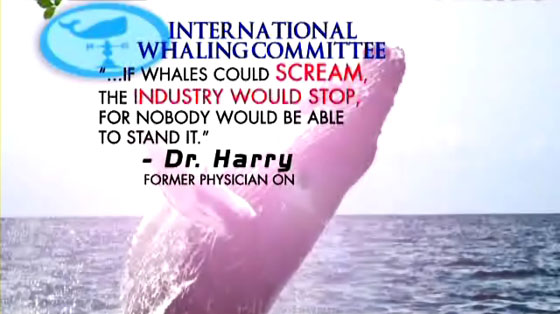The images in the following program are very sensitive and may be as disturbing to viewers as they were to us. However, we have to show the truth of animal cruelty.
HOST: Compassionate viewers, welcome to today’s Animal World: Our Co-Inhabitants, for our Stop 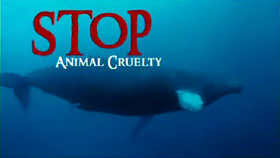
Animal Cruelty series, where we will investigate the inhumane practice of hunting innocent, sensitive whales. Whales and dolphins, which belong to the order Cetacea, are mammals and so are warm-blooded, breathe air and give birth to live young. These gentle giants of the sea are also extremely intelligent. It is estimated that the average Beluga Whale has an IQ of 155, which in human terms is genius level. It is estimated that the great artist, visionary and inventor Leonardo da Vinci had an IQ of 158.
Mr. David Gomez of the Coalition for Animal Rights (CDA) in Chile explains more about the intricate roles whales play in our marine ecosystem.
Mr. Gomez(m):
Whales are one of the largest animals in the world; one of the largest marine mammals that exist and they play a vital role in the marine ecosystem.
One of their characteristic as animals is that they are animals of great intelligence. They live in groups, raising their children over a long period of time and according to studies, the songs that are very attributed to them follow certain patterns that can even be compared with patterns of human language, thus it can be deduced that whales have a linguistic system of some kind.
Moreover, according to the regions where the whales live, these songs have specific characteristics, so it is plausible that there are differences like those of human dialects, which vary depending on the region that groups of people live.
So it is thought that there are whale dialects, according to the parts of the ocean where they live.
Supreme Master TV(m):
And could you tell us something about the way the care for their babies?
Mr. Gomez(m):
As they are mammals, the baby needs to be with the mother for a long time, months, even years, depending on the type of whale. All kinds of whales care for their children in groups because they are social animals and travel long distances depending on the season of the year and according to the feeding required by the type of whale.
HOST:
However, despite their sensitive, caring natures, these marine beings have been hunted almost to the point of extinction.
To monitor the situation, the global community established the International Whaling Committee (IWC) in 1946. The IWC was formed after Dr. Harry D. Lillie, who served as a physician on a whaling ship, made the following statement: “If we can imagine a horse having two or three explosive spears stuck into its stomach and being made to pull a butcher’s truck through the streets of London while it pours blood in the gutter, we shall have an idea of the present method of killing. The gunners themselves admit that if whales could scream, the industry would stop, for nobody would be able to stand it.”
In 1986, the IWC completely banned commercial whaling in order to protect the dwindling numbers of whales such as the Humpback, of which only 20,000 remain in the Pacific Ocean. But despite the ban some countries continue to mercilessly hunt whales.
Mr. Gomez(m):
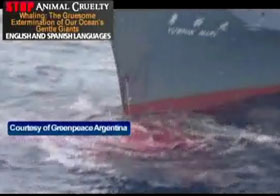 Now the abuse is clearly whale hunting. According to the International Whaling Commission, there are three types of hunting: aboriginal, scientific and commercial.
Now the abuse is clearly whale hunting. According to the International Whaling Commission, there are three types of hunting: aboriginal, scientific and commercial.
In the aboriginal hunt, certain ethnic groups are allowed to hunt to maintain their so-called “culture,” for example 5, 10 or 15 whales each year. However, there is no need to do this, and we are in the 21st century, we have more access to food, not like 200 or 500 years ago.
The scientific hunt allows hunting for research purposes, now this hunt is very tied to commercial hunting which is prohibited internationally. Japan, for example, hunts annually in the Antarctic, about a thousand whales for supposedly scientific purposes, to research for example what happens in the middle ear of whales, what they eat. For that they hunt 1000 whales which then, allegedly to finance the research, end up in restaurants, and even as hamburgers in supermarkets. Also in the North Atlantic, for example, whales are hunted by vessels which are mainly Norwegian and Irish. In the Antarctic, here in the South Pacific, in the North Pacific too, they are still hunted.
HOST:
During a chase whales suffer physically from a condition known as “exertional myopathy” and some are so sensitive that they die from the shock and exertion of the chase alone.
Mr. Gomez(m):
Nowadays, the way it is done is to pursue groups of whales with whaling ships and when they are a certain distance from the whale, when it comes up for air, a harpoon is shot called a grenade harpoon. The harpoon has an explosive tip and where the whale is hit, it explodes, this makes the harpoon go inside and the whale starts bleeding for what can be 10 minutes, half an hour or longer; the whale is in agony, missing a piece of its body.
HOST:
Once the harpoon is embedded inside the whale, the grenade explodes, causing massive trauma and internal bleeding from lacerations. In addition, shock waves from the blast cause neurotrauma, that is, brain and spinal chord damage. In most cases, the whales are fully conscious as they die slowly from their horrific wounds.
So profuse is the bleeding that many harpooned whales spew blood from the blow holes on top of their heads. On the tips of the harpoons lie two spring-loaded claws that extend into the animal’s flesh so as to anchor the line or rope, which is now tethered to the vessel.
These claws cause further injury and pain as they widen the hole by more than 60 centimeters.
Mr. Diego Toboada, president of the Whale Conservation Institute in Argentina describes the sad fate of these magnificent ocean beings.
Diego Taboada, President of the Whale Conservation Institute (ICB) - Argentina:
These whales are just harpooned from a boat and after that they carry them to a bigger ship, a factory ship, where they are processed and become blocks of meat that go to the port.
HOST:
When Animal World: Our Co-Inhabitants returns, we will further investigate the cruelty of whaling. Please keep your dial tuned here to Supreme Master Television.
HOST:
Welcome back to Animal World: Our Co-Inhabitants and our Stop Animal Cruelty series. In today’s program we are investigating on the inhumanity and suffering our whale friends suffer. Whalers first use a penthrite harpoon to hunt whales, and if it does not kill the whale quickly enough, a secondary weapon is deployed, usually another explosive harpoon.
Mr. Michael Alvarez-Toye, spokesperson of the Calgary Animal Rights Coalition in Canada describes the cruel secondary methods used to slaughter whales.
Mr. Michael Alvarez-Toye (m): 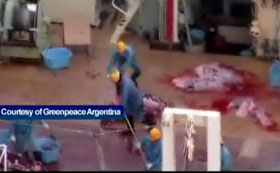
With respect to the whales, we’ve established a cruelty of slaughtering these creatures through the use of harpoons, grenade-tip. Sixty percent die lingering deaths, painful deaths with wholes punched into them. They don’t die quickly enough with the first harpoon, often time a second one is used and/or rifles with a minimum 9.3 mm caliber. It’s unbelievable if you see up-close the actual killing of a whale.
HOST:
There is no upper limit to the number of bullets that can be used; it could be as high as 200 rounds. Each burning piece of metal pierces through the animal’s body, causing searing pain as well as internal organ damage and bleeding.
Mr. Michael Alvarez-Toye (m):
These are animals that flee their killers. The chase is given till these animals are starved of oxygen, tired. And yet they still fight and run. Not fight as an aggression, but fight as they have this will to live, this will to escape their predators, even as they tiring out.
HOST:
An International Whaling Committee report concluded that two of every 16 whales die from asphyxiation. This happens when the whale is harpooned in the tail area and hauled out of the water so that its head and blow hole are submerged, causing it to suffocate and drown.
Sometimes the animal is hauled onto the factory boat still alive. It is known that some whales are still alive and capable of feeling pain as they are sliced open, butchered and processed. The bleeding of these gentle giants is so profuse that the factory ship deck is submerged in 6 to 8 centimeters of blood.
Worse still, 60% of all females caught are pregnant and the fetus usually dies shortly after the mother, or it is brutally killed.
Dr. Lance Barrett-Lennard who is head of the Cetacean Research Program at Vancouver Aquarium and an adjunct professor of zoology at the University of British Columbia explains that the fatalities of whales extend beyond just the number that are harpooned and brought onto ships.
Dr. Lance Barrett-Lennard(m):
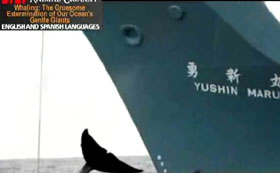 We know that when an old female dies, the mortality of her sons at least, the chance that her sons will die over the next year or so goes up. These old females are very important to the population. If something happens to an old female, if an old female is startled, everybody in the group reacts. And if a young animal is startled that doesn’t occur.
We know that when an old female dies, the mortality of her sons at least, the chance that her sons will die over the next year or so goes up. These old females are very important to the population. If something happens to an old female, if an old female is startled, everybody in the group reacts. And if a young animal is startled that doesn’t occur.
So these kinds of relationships and accessing who is most important, who do they interact with most in these groups happens in Orca societies, just the same way it does in human societies.
HOST:
In addition to captured whales, significant numbers are categorized as “struck and lost,” meaning they have either been hit by harpoons or shot but have managed to escape. These animals almost certainly die from their wounds. Whether caught or lost, the anguish is not limited to the whale itself but extends to its entire pod.
Dr. Lance Barrett-Lennard(m):
One thing you see that’s very striking is that if a calf dies, it’s mother may carry its body around for days, sometimes even weeks and the group of whales will sometimes hold up a dying companion or even a dead companion at the surface for long, long periods of time.
HOST:
All of the methods of capturing and killing whales run counter to the humane slaughter and animal welfare standards set by the World Organization for Animal Health (OIE), an intergovernmental body responsible for improving animal health, comprised of 172 member nations and recognized as a reference group by the World Trade Organization (WTO).
There are still countries that are seeking to overturn the International Whaling Committee ban to resume commercial whaling. To stop the death of thousands of whales, please write to your government telling them how you feel about these atrocious acts.
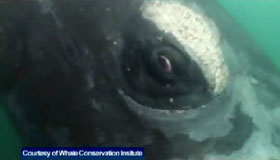 Michael Alvarez-Toye (m): For those who would like to help bring an end to the whaling industry, and it has to be done now, because every year passing means more thousands of whales killed, murdered. Contact organizations such as Sea Shepherd, contact your own officials.
Michael Alvarez-Toye (m): For those who would like to help bring an end to the whaling industry, and it has to be done now, because every year passing means more thousands of whales killed, murdered. Contact organizations such as Sea Shepherd, contact your own officials.
Many countries are opposed to whaling. By working with your own country, by letting your own voice stand up, by organizing rallies, and saying that we will not be a part of this carnage, it’s the most effective way, because without a voice we have nothing. Thank you.
HOST:
May we all adopt vegan lifestyle to stop the suffering of all animal co-inhabitants, on land, in the air and in the sea.
For More Information,Please visit the following:
Coalitian for Animal Rights(CDA) - Chile: www.derechos-animales.com
Whale Conservation institute(ICB) - Argentina: www.icbargentina.com.arian
Calgary Animal Rights Coalition - Canada:
Michael Alvarez-Toye
Tel: (403) 262 -3458
Email: malvareztoye@yahoo.com
Department of Zoology, University of British Columbia - Canada:
www.zoology.ubc.ca
